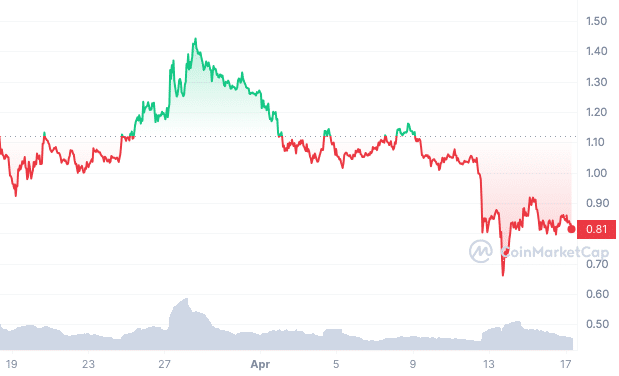In an extraordinarily bold move to disrupt the growing monopolization of artificial intelligence (AI) by major tech giants, three leading AI-focused crypto projects have announced plans to merge their tokens and form a new decentralized AI alliance.
SingularityNET, Fetch.ai, and Ocean Protocol have agreed to consolidate their native tokens – AGIX, FET, and OCEAN respectively – into a single new token called ASI. The merged entity, dubbed the Artificial SuperIntelligence (ASI) Alliance, aims to create an expansive decentralized network that can rival the AI dominance of companies like Alphabet (GOOG), Microsoft, and Meta Platforms.
With a combined fully diluted market cap estimated at $7.5 billion, the ASI token is poised to become one of the largest and most influential players in the burgeoning blockchain-powered AI space.
The move marks a significant shift in the landscape, as other niche projects could also opt to band together to challenge the dominance of traditional tech companies in multiple spaces going from the metaverse to financial technology.
Key Highlights: AI Alliance and ASI Token Merger
- Alliance Formation: SingularityNET, Fetch.ai, and Ocean Protocol have merged their tokens to create the ASI token, forming the Artificial SuperIntelligence (ASI) Alliance. This aims to challenge AI dominance by tech giants like Google and Microsoft.
- Token Mechanics: The ASI token consolidates the capabilities of AGIX, FET, and OCEAN, powering a decentralized AI ecosystem with a focus on secure data access and machine economy transactions .
- Community-Driven Governance: Governance of the ASI Alliance is overseen by a council with representatives from each project. The community-driven approach ensures alignment with token holders’ interests, fostering decentralized decision-making.
- Strategic Goals: The alliance aims to democratize AI development, providing an open alternative to proprietary AI models. This could attract developers and users seeking transparency and ethical AI practices .
- Challenges Ahead: The alliance must navigate regulatory complexities and prove its technological capabilities to compete with major AI firms. The success of ASI will depend on community support and overcoming market volatility.
Joining Forces to Keep Advancing a Decentralized AI Platform

The driving force behind the token merger is a shared vision among the three projects to advance the development of Artificial General Intelligence (AGI) and Artificial Superintelligence (ASI) in an “open, democratic, and decentralized way”, as SingularityNET´s CEO Dr. Ben Goertzel puts it.
“The token merger brings us closer to that goal and strengthens our ability to challenge Big Tech’s control over AI.”, Goertzel explained.
Meanwhile, Fetch.ai CEO and ASI Alliance Chairman Humayun Sheikh echoed these sentiments, emphasizing the importance of fostering ethical and transparent AI development outside the walled gardens of large corporations.
Finally, Bruce Pon, the top boss at Ocean Protocol, commented: “The unified ASI token is the glue to orchestrate all actors with common incentives. ASI tokens are used to secure the public network, as data access tokens and to unlock computation without needing traditional banking and payment rails. It is the native currency for the machine economy.”
By merging their platforms and tokens, the three projects aim to create a robust decentralized infrastructure that can rival the AI capabilities of tech conglomerates while also upholding principles of openness and community governance.
The ASI Token and Governance Structure
Under the terms of the merger, FET will be rebranded as the new ASI token, with a total supply of 2.63 billion tokens. The native tokens of SingularityNET and Ocean Protocol will also be migrated to ASI, with conversion rates of 0.433350:1 and 0.433226:1 respectively.
The new ASI token will serve as the primary currency powering the Alliance’s decentralized AI ecosystem, facilitating secure data access, computation, and other machine economy transactions. The token’s value proposition will be underpinned by the combined technological capabilities and user bases of the three merged projects.
Governance of the ASI Alliance will be overseen by a council comprising key figures from each founding project. Fetch.ai’s Humayun Sheikh will serve as the project’s Chairman and SingularityNET’s Ben Goertzel will serve as CEO of the new entity. Meanwhile, Ocean Protocol’s Trent McConaghy and Bruce Pon will be holding board seats.
The formal establishment of the was is contingent on approval from the individual communities of each project through a voting process. Today, these voting procedures have all been completed meaning that their communities are fully on board with this new vision. The merger should be completed in May according to the project’s whitepaper.
This community-driven approach is intended to ensure that the merger aligns with the values and interests of the token holders, who will ultimately be responsible for shaping the future of the decentralized AI network.
Defying the AI Status Quo Means to Take On Big Tech Firms
The main impetus behind the ASI Alliance is the growing concern over the concentration of power and influence in the hands of a few major tech companies when it comes to AI development and deployment.
As artificial intelligence becomes increasingly central to the digital economy, experts fear that the platforms created by titans of the industry like Google, Microsoft (MSFT), and OpenAI, could establish an effective oligopoly over the technology, controlling access to critical AI models, datasets, and infrastructure.
“This has been the joint vision of SNET, Fetch.ai, and Ocean Protocol from their inception, and for this reason, it makes total sense that our three projects come together to form a tokenomic network that has greater power to take on Big Tech and shift the center of gravity of the AI world into the decentralized ecosystem.”, Goertzel stressed.
The ASI Alliance believes that by pooling their resources and expertise, they can create a viable alternative to the AI offerings of large tech firms, providing users and developers with more transparent, ethical, and community-driven AI solutions.
“The impact of [our proposed] system may greatly exceed what we’ve seen from significant LLMs and lead the global economy into a new era of beneficial decentralized AGI and ASI.”, he concluded.
Potential Risks and Challenges of the Merger
While the merger of these three prominent AI crypto projects has generated significant excitement in the community, it is not without its risks and challenges.
The success of the ASI Alliance hinges on its ability to gain widespread adoption and become the preferred platform for decentralized AI development and applications. This will require not only technological superiority over incumbent solutions but also effective marketing, community engagement, and onboarding of developers and users.
There is also the question of whether the three founding projects can truly operate as independent entities under the ASI banner or if the new governance structure will lead to conflicts and power struggles that hamper the Alliance’s progress.
Moreover, the regulatory landscape surrounding AI and crypto remains uncertain, with policymakers still struggling to effectively monitor the emergence of issues like data privacy, security, and anti-trust concerns. Any adverse regulatory actions or policy changes could significantly impact the ASI Alliance’s operations and growth prospects.
Lastly, the natural volatility of the crypto market poses a risk to the token’s value and the overall financial feasibility of the project. In this regard, a major market downturn or loss of investor confidence could undermine the ASI Alliance’s ambitious plans.
Despite these challenges, the founders of the ASI Alliance remain confident in their ability to disrupt the AI landscape and provide a decentralized alternative to the tech giants’ dominance.
“We’re glad that the Fetch and SingularityNet communities have cleared this hurdle and approved the token merger”, said Ocean Protocol’s CEO Bruce Pon. “We’re excited to get started”.

Although the three tokens experienced significant upticks in late March after rumors of the merger started to spread, the overall weakness that the crypto markets have experienced in the past few days has plunged the prices of AGIX, FET, and OCEAN alike.
In the past 30 days, the three tokens have experienced losses of 28%, 24%, and 25% respectively.
Wider Implications for the Crypto Sector
The ASI Alliance’s token merger is a significant event in the rapidly evolving crypto space that could have far-reaching implications for the industry as a whole.
The merger is considered part of a growing trend of consolidation and collaboration among crypto projects, as they seek to scale, leverage synergies, and present a united front against larger and better-resourced competitors.
This could spur more mergers and acquisitions in the sector as projects with complementary technologies and user bases recognize the value of joining forces.
Additionally, the ASI Alliance’s focus on decentralized AI development aligns with broader industry trends toward Web3 and the democratization of technology. As the influence of major tech firms continues to expand, crypto projects positioning themselves as alternative, community-driven platforms may find increasing appeal among users and developers.
Moreover, the success or failure of the ASI Alliance could serve as a bellwether for the feasibility of decentralized approaches to complex technological challenges like AI. If the Alliance can demonstrate the power and operational efficiency of its new model, it may inspire other crypto projects to pursue similar collaborative efforts in various industry verticals.
Ultimately, the launch of the ASI token and the formation of the Artificial Superintelligence Alliance may be crypto’s only chance to disrupt the status quo in the AI space. While the path ahead may be turbulent, the potential rewards of creating a more open, democratic, and decentralized AI ecosystem are significant for both the crypto industry and the future of technology as a whole.
